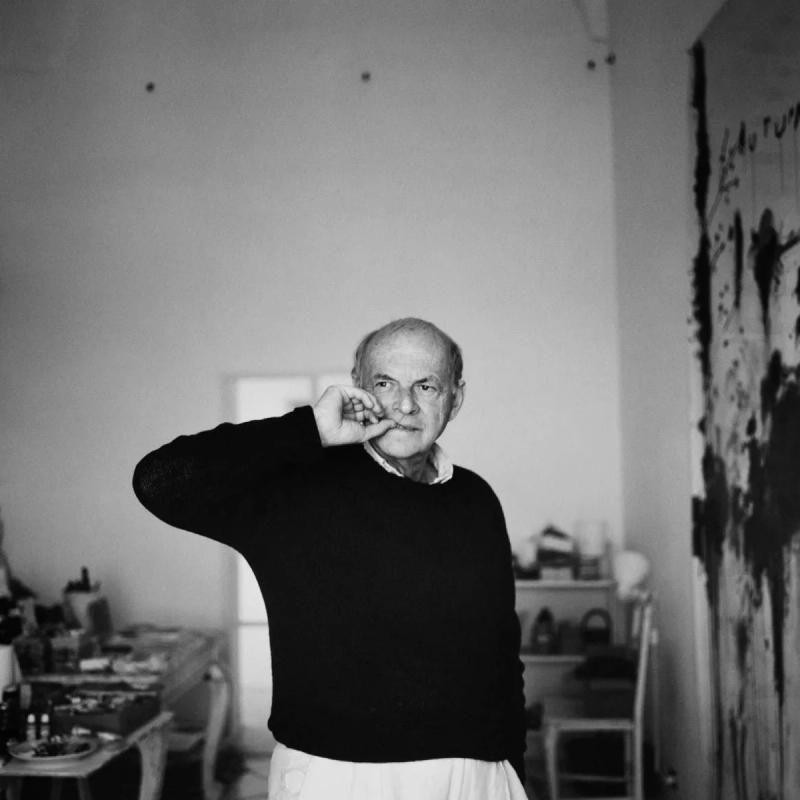Cy Twombly
“It’s more like I’m having an experience than making a picture.”
One of the most significant painters of the twentieth century, Cy Twombly (1928–2011) developed an individual lexicon of spontaneous marks, calligraphic scrawls, and sweeping gestures that refused modernism’s formal harmony. Reflecting a deep engagement with antiquity and literature, Twombly’s paintings feature repetitive scratches, drips, erasures, bursts of pigment, glyphs, and penciled passages of verse, subverting various conventions and categories of drawing and painting, text and image. In 1957, he wrote that each line he made was “the actual experience” of creating the line, observing: “It does not illustrate. It is the sensation of its own realization.” His practice emerged beside but skirted Abstract Expressionism and was later contextualized with Minimalism; in the 1980s, the rise of neo-Expressionism brought newfound critical appreciation to his work.
Born Edwin Parker Twombly Jr. in Lexington, Virginia, the artist attended the Boston Museum School and Washington and Lee University in Lexington. In 1950, he received a scholarship to the Art Students League and moved to New York. There, he met Robert Rauschenberg, who urged him to enroll at North Carolina’s Black Mountain College, and, with whom he later traveled to Italy, North Africa, and Spain between 1951 and 1953. In 1951, Twombly mounted his first New York solo exhibition at the Kootz Gallery, and in 1953 he began exhibiting with Eleanor Ward’s Stable Gallery in New York. That year, he was drafted to work as a cryptographer for the army. In 1957, Twombly settled in Rome, where he made diagrammatic works brimming with eroticism and later his more subdued “blackboard” paintings. In 1958, he began showing with Leo Castelli. Over the following decades, Twombly traveled widely and created drawings, collages, photographs, prints, and sculpture in addition to his lyrical canvases; his final residence was in Gaeta, Italy.
Twombly’s work has been the subject of major retrospectives organized by such museums as the Milwaukee Art Center (1968); Kunsthalle Bern (1973); Whitney Museum of American Art, New York (1979); Kunsthaus Zürich (1987); Museum of Modern Art, New York (1994); Tate, London (2008); and Art Institute of Chicago (2009), among numerous others. In 1989, the Philadelphia Museum of Art opened permanent rooms housing his monumental painting cycle Fifty Days at Iliam, and in 1995, the Menil Collection in Houston inaugurated a gallery dedicated to his work. In 2010, the Musée du Louvre, Paris, unveiled a commissioned ceiling painting comprising 3,750 square feet of the museum’s Salle des Bronzes. Twombly participated in Documenta, Kassel, in 1982 and in the Venice Biennale in 1964, 1980, 1988, and 2001, when he was awarded the Golden Lion. Among numerous recognitions, he received a Praemium Imperiale award from the Japan Art Association in 1996.
Exhibitions
- Audible Presence: Lucio Fontana, Yves Klein, Cy Twombly
- Dominique Lévy, New York
September 18 - November 16, 2013 Audible Presence: Lucio Fontana, Yves Klein, Cy Twombly (2013) was the inaugural exhibition of Dominique Lévy at 909 Madison Avenue, New York. The exhibition explored the relationship between the time-based procedures employed by three of the most influential artists of the twentieth century and the auditory experiences of music, sound, and silence. In conjunction with the exhibition, Dominique Lévy presented New York City’s first public performance of Yves Klein’s Monotone-Silence Symphony, which was performed only once during the artist’s brief lifetime, on the night...
Read More
Selected Press
- T MagazineJanuary 27, 2016
- LA TimesDecember 28, 2013
- New York TimesOctober 17, 2013
- Haute LivingOctober 7, 2013
- Art ObservedSeptember 26, 2013
- The Daily BeastSeptember 26, 2013
- New York TimesSeptember 19, 2013
- Animal New YorkSeptember 19, 2013
- The Daily BeastSeptember 19, 2013
- Interview MagazineSeptember 18, 2013
- New York TimesSeptember 17, 2013
- Architectural DigestAugust 31, 2013
- ArtdailyAugust 5, 2013
